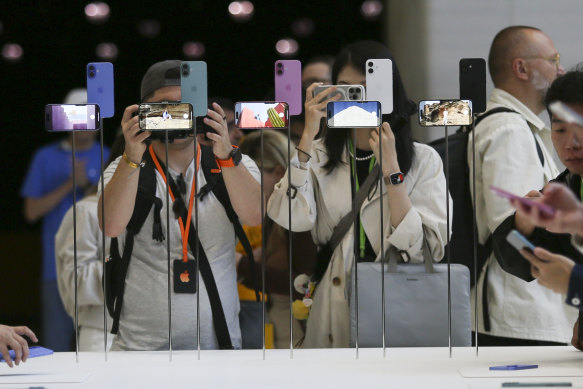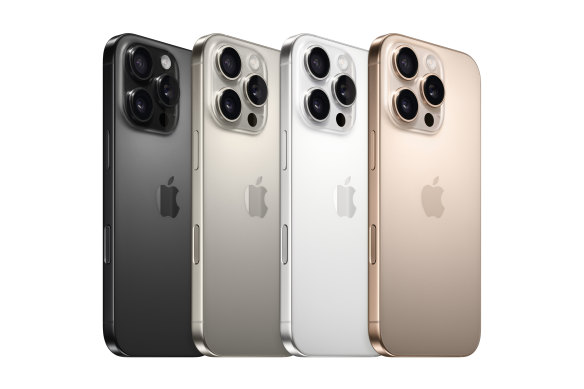
The button sits low on the right-hand side of the phone, and it’s sensitive to touch and pressure.
Pressing it in opens the camera app immediately (which means I can finally have the Action button do something else), and from there, you can scroll to zoom or choose tools, press it lightly or fully, or double-press to achieve various functions.
It’s an interesting feature, given that it’s already quite easy to operate the iPhone’s camera, but being able to keep both hands firmly on the frame rather than touching the screen seems like a nice improvement. I’m most curious to know if part of the impetus for this button is that it will make future augmented reality features easier to use, such as the “visual intelligence” feature we briefly saw teased at the event.

Attendees take a closer look at the Apple iPhone 16 after its announcement.Credit: AP
The Pro difference
In some ways, the gap between the standard phones and the Pro models has closed a little this year, with big upgrades in processing, cameras and features for the iPhone 16 and 16 Plus. They now have the action button, are getting the same capture button as the Pros, have a variant of the same A18 chip, will run Apple Intelligence and have new cameras for standard, 2x zoom, ultrawide and macro shots. But on the other hand, the Pro models are getting impressive upgrades elsewhere.
The new Pros have shrunken screen borders for even bigger screens, coming in at 6.3 inches and 6.9 inches versus the standard iPhones’ 6.1 and 6.7 inches. The Pros keep the advantage of a telephoto lens (with the 5x zoom coming to both Pro models this year) and 120Hz screen refresh rate, and this year, they also get some new features that should appeal to creators.
The camera setup is capable of shooting 4K Dolby Vision HDR at 120Hz, in ProRes and Log formats, direct to external storage if needed. That means you can take the footage and then adjust the level of slow-motion while editing on the phone. For stills, the Pro phones can take 48MP ProRAW or HEIF photos with no shutter lag, and the new capture button gives quick access to various pro tools. With an update coming in the future, Apple said the capture button on Pro would be able to work like a two-stage shutter, locking in focus and exposure with a half press and taking the image at full.
The company also showed off an update on Pro phones for the Voice Notes app, which it says is frequently used by artists to record ideas for songs. The feature lets users play back a recorded note and record a second layer over the top, cancelling the noise of the original in a way that would traditionally require headphones.

The iPhone 16 Pro has a slightly larger screen and a bigger battery.
Price adjustment
In the US, the price of iPhones has stayed the same for several years. But given fluctuating global currencies, that hasn’t been the case here. Somewhat surprisingly, this means the iPhone 16 lineup is actually slightly less expensive in Australian dollars than the iPhone 15 was at launch, down by $100 for the standard smaller phone and $50 for the others.
Loading
That’s not to say the phones are anywhere near inexpensive, of course. If we skip the 128GB models and look only at the 256GB, which I’d argue is the bare minimum for pretty much everybody, the four phones start at $1600, $1800, $2000 and $2150, i.e. they’re still some of the most expensive phones around.
As always, Apple has taken the opportunity of new phones to rejig its entire lineup, so if you’re buying from the company directly, you’ll find the current range (again with 256GB) looks like this:
- iPhone SE (2022): $970
- iPhone 14: $1250
- iPhone 14 Plus: $1450
- iPhone 15: $1450
- iPhone 15 Plus: $1600
- iPhone 16: $1600
- iPhone 16 Plus: $1800
- iPhone 16 Pro: $2000
- iPhone 16 Pro Max: $2150
AirPods lineup
The different AirPod models have been a bit tricky to keep track of over the years, with some versions getting an entirely new name while others just get a subtitle, and some new features only coming to optional charging cases or rolled out everywhere by software updates. For the last little while, we’ve had a lineup of AirPods 2 (with the long stems), a more premium AirPods 3 and the high-end AirPods Pro 2. The lineup as it stands after today’s event doesn’t do much to fix the awkward naming conventions, but it does provide a clean “good, better, best” proposition.
At the lowest end, you have the new AirPods 4 at $220. These are powered by Apple’s H2 chip so you get the large bulk of all the latest audio features, including personalised spatial audio, head tracking, automatic switching between devices and accessibility features. The buds have a squeezable sensor for playback controls, though there is no way to change volume without asking Siri or using a different device like your phone. With the buds and USB-C charging case combined, you get 30 hours of listening before needing to plug in.
Loading
The middle $300 option is virtually the same thing but with active noise cancellation, and it’s creatively called AirPods 4 with Active Noise Cancellation. It’s the same traditional AirPods shape that hooks into your ear, so you’re certain to be getting some noise in from the outside, but the buds support the same modes as the AirPods Pro: cancellation, adaptive, transparency and conversation awareness. The case is a bit nicer, too, with wireless charging and a speaker, so it will beep if you lose it and activate Find My. If you’re using noise control, you’ll only get 20 hours of battery in total.
Finally, the premium option is still the $400 AirPods Pro 2, which is unchanged. They have silicon tips to seal your ear, can boost conversation volume, reduce loud sounds, control volume with a swipe and last 30 hours even with ANC on. The case has wireless charging and MagSafe, a speaker and lanyard loop, and an ultra-wideband chip, so your phone can point you to where you left it.
Get news and reviews on technology, gadgets and gaming in our Technology newsletter every Friday. Sign up here.









 Add Category
Add Category